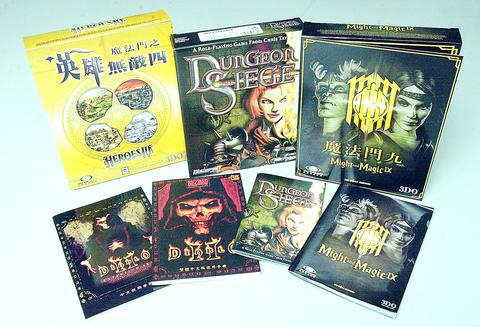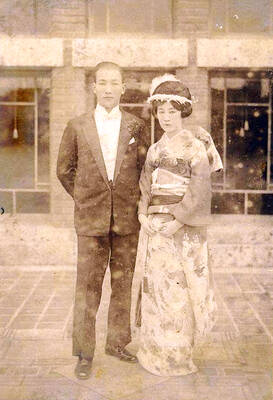The huge success of the film Lord of the Rings has not only made thousands of Taiwanese intimately familiar with the fantasy world of Middle Earth, it has also helped in establishing the popularity of a new generation of games which are making their first step onto the local market.
Currently Dungeon Siege, which is filling the premium display space in computer stores, is pushing Diablo II off the shelves as the most sophisticated and popular product with gamers.
In seeking to recreate the world of Middle Earth and the adventures of the fellowship in the role-playing game (RPG) format, complete with the mind-blowing scenery that Rings has made a virtually essential element of any fantasy gaming environment, Dungeon Siege is leading the way. On one level, game designers have been pushing for almost cinematic effects in the game environment as an important hook to create appeal for hard-core gamers and new players alike.

PHOTO: CHIANG YING-YING, TAIPEI TIMES
"Even in the virtual world of the game, the graphics engine is able to create endless snowscapes and cliffs of ice that look almost real. With the addition of a zoom capability, players can become totally engrossed in the movie-like story," said Antonio Lu (
"It's been many years since I have been so engrossed in a game that I have played it non-stop for two days," said Nabil Hsieh (
The enormous appeal of Dungeon Siege is its combination of two until now distinct gaming styles. "It is a mixture of the Baldur's Gate series and Diablo II. It combines the team combat concept of the former and the hand-to-hand intensity of the latter," Hsieh said.
The complexity of Baldur's Gate restricted its appeal to new gamers, who often found the move-by-move combat, in which the player needed to control characters individually, tedious. Diablo II made the shift to a relatively automated model in which a player can set up a basic strategy (for example, wizards and archers fighting in the second rank) and simply point and click at the target enemy. A total of eight characters can be controlled in this way, greatly speeding up play, especially for novices.
Diablo II received highly favorable comment when it was first released in Taiwan, and in its attention to graphics and detailed conception of its virtual world, was the prototype for many similar games that followed. While supporters believe that Dungeon Siege has made the next step in developing RPG gaming, critics point to a number of failings that include a lack of dramatic tension in the game and a lack of balance between character types.
"Dungeon Siege has nine chapters to its story, and although each has beautiful graphics, the virtual world it creates is not very significant in game terms. In Diablo II, different environments require players to alter their equipment and their strategy," said Lin Yi-shun (林以舜), a translator for computer games currently working with Interwise. "Other critics have pointed out that in online play, there is not sufficient tactical interrelation between character types, so that archers are not very effective and wizards are killed off too easily," he added.
Another criticism of Dungeon Siege is that it makes no attempt to recreate the narrative integrity of Baldur's Gate. Each chapter is simply a killing off of various monsters culminating in a final challenge against the Wizard King. The branch stories -- finding someone who is lost, clearing out a dungeon -- are not integrated, Lin said.
Hans Chuang (莊承漢), product manager for Unalis Corp (松崗電腦), who distributes the game in Taiwan, said the designers of Dungeon Siege made these sacrifices to reduce the complexity of the game.
"This was done to achieve `ease of play,'" he said. "I believe that on the foundations established by Dungeon Siege, a whole range of richer and deeper fantasy worlds will be created."
Another move to creating a more realistic and "freer" virtual world is Bethesda Softworks' Elder Scroll: Morrowmind which is expected to be released by Taiwan Interwise Multimedia (
According to Interwise president Dell Yu (余如山), this is a game designed "for players to play over several years." He said that Morrowind was a virtual world in which players can exist without the pressure to solve puzzles or get to the next level within a certain time that characterizes most RPG formats. "The game's graphics engine is able to create very realistic indoor and outdoor environments, and the adventure is accompanied by orchestral music. "Each person can have a unique adventure experience in this game," Yu said.
Interwise, who invested heavily in localizing Baldur's Gate -- creating a Chinese-language version -- will do the same for Morrowind. Yu, who is working on the localization of Morrowind, said that the enormous depth and complexity of the game really means that players can spend years exploring it. "Morrowind has over 30 towns, selected from a total of over 100 designs, has more than 3,000 non-player characters, 300 underground adventures, 500 `basic' spells for mages and 200 kinds of plants," Yu said. "Just think how much time you need to experience everything."
But Morrowind, despite its great complexity, has taken a leaf out of Dungeon Siege's book, and simplified the setup process for the game. At the start of the game, only three professions are offered players, and no change of profession is possible in the course of play. "Character development depends on the choices players make during the game and which skills they choose to train in," Yu said.
Dungeon Siege and Morrowind are far from being the only games recently released onto the RPG market, but other recent releases have proved unable to think outside the box of conventional RPG gaming. The release of Might and Magic 9 was anticipated for its much-hyped 3D graphics and team combat model, but for hard-core RPG gamers, it was ultimately a disappointing reworking of conventional formulas.
Ironically, it was Heroes 4 (part of the Might and Magic series), which did not try for any innovation other than going 3D (previous editions had been 2D), which sold considerably better than the more ambitious Might and Magic 9.
"Of the big three RPG series, Wizardry and Ultima Online [the third being Might and Magic] have already announced that they will not be releasing any new editions. It is no surprise that Might and Magic has become a focus of intense interest for RPG gamers. Unfortunately, expectations were probably too high, and although Might and Magic 9 and Wizardry 8 both tried hard for creative breakthroughs, the results have been disappointing.
"Now it is up to Morrowind [from the relatively minor firm of Bethesda Softworks] to bring new life into RPG gaming," Lu said.

Sept. 1 to Sept. 7 In 1899, Kozaburo Hirai became the first documented Japanese to wed a Taiwanese under colonial rule. The soldier was partly motivated by the government’s policy of assimilating the Taiwanese population through intermarriage. While his friends and family disapproved and even mocked him, the marriage endured. By 1930, when his story appeared in Tales of Virtuous Deeds in Taiwan, Hirai had settled in his wife’s rural Changhua hometown, farming the land and integrating into local society. Similarly, Aiko Fujii, who married into the prominent Wufeng Lin Family (霧峰林家) in 1927, quickly learned Hoklo (commonly known as Taiwanese) and

The low voter turnout for the referendum on Aug. 23 shows that many Taiwanese are apathetic about nuclear energy, but there are long-term energy stakes involved that the public needs to grasp Taiwan faces an energy trilemma: soaring AI-driven demand, pressure to cut carbon and reliance on fragile fuel imports. But the nuclear referendum on Aug. 23 showed how little this registered with voters, many of whom neither see the long game nor grasp the stakes. Volunteer referendum worker Vivian Chen (陳薇安) put it bluntly: “I’ve seen many people asking what they’re voting for when they arrive to vote. They cast their vote without even doing any research.” Imagine Taiwanese voters invited to a poker table. The bet looked simple — yes or no — yet most never showed. More than two-thirds of those

In the run-up to the referendum on re-opening Pingtung County’s Ma-anshan Nuclear Power Plant last month, the media inundated us with explainers. A favorite factoid of the international media, endlessly recycled, was that Taiwan has no energy reserves for a blockade, thus necessitating re-opening the nuclear plants. As presented by the Chinese-language CommonWealth Magazine, it runs: “According to the US Department of Commerce International Trade Administration, 97.73 percent of Taiwan’s energy is imported, and estimates are that Taiwan has only 11 days of reserves available in the event of a blockade.” This factoid is not an outright lie — that

Former Chinese Nationalist Party (KMT) chairwoman Hung Hsiu-chu’s (洪秀柱) attendance at the Chinese Communist Party’s (CPP) “Chinese People’s War of Resistance Against Japanese Aggression and the World Anti-Fascist War” parade in Beijing is infuriating, embarrassing and insulting to nearly everyone in Taiwan, and Taiwan’s friends and allies. She is also ripping off bandages and pouring salt into old wounds. In the process she managed to tie both the KMT and the Democratic Progressive Party (DPP) into uncomfortable knots. The KMT continues to honor their heroic fighters, who defended China against the invading Japanese Empire, which inflicted unimaginable horrors on the